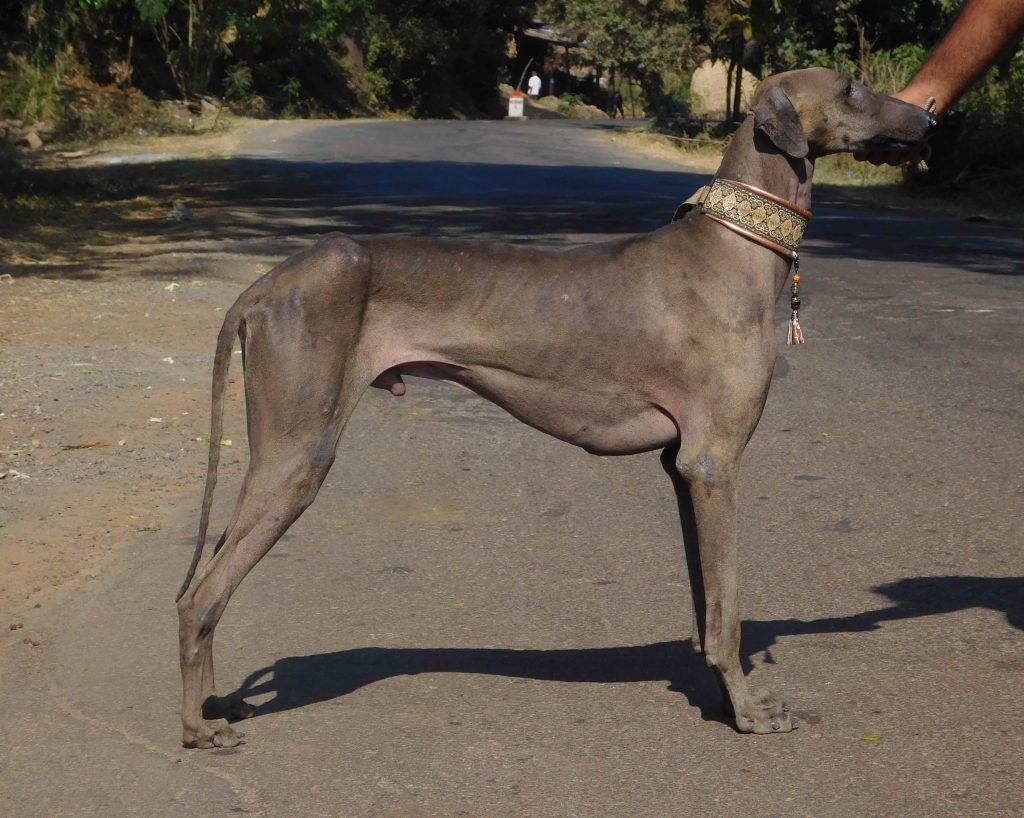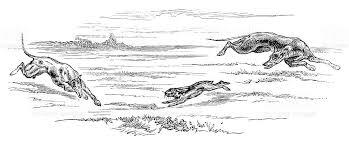The official Breed standard for the caravan hound!

BRIEF HISTORICAL SUMMARY: The Caravan hound is endemic to the Deccan plateau of India, especially in the southern region of the state of Maharashtra. Dogs have been traded in and out of India by caravans of the travelers from all over Asia in the past, from which this breed has derived adapting to the habitat. Hence the name Caravan hound. Although the slight variations can be found in its region of distribution due to local preference but overall type is fairly fixed and recognizable. The Caravan hound is first and fundamentally a swift and agile hunter. It is a hardy dog, used to work under difficult circumstances on rough terrain with minimal maintenance.
GENERAL APPEARANCE: A short haired, lop‐eared, working sight hound of Asiatic type; built for running long distances over difficult terrain in acute heat. The body is of square format, with moderate angulation, and lean musculature. The overall impression should be that of a light boned, refined, yet well balanced sight hound, without exaggeration in built. The Caravan Hound should be elegant, graceful, possessing courage and combining muscular power with speed and great endurance to enable him to chase and kill the Blackbuck, Fox, jackal or a Chinkara, and the Indian hare.
IMPORTANT PROPORTIONS: The Caravan Hound should be of square format. Never very longer than tall but can be slightly taller than long. The length of the body (from point of shoulder to point of buttock) is approximately equal to the height at the withers.
BEHAVIOUR / TEMPERAMENT: Affectionate with family, very reserved with strangers. Defends his master and his property in case of need. The Caravan Hound looks at and through one.
Origin: India
Utilization: Sight Hunting
FCI Classification: Group 10 Sight hounds Section 3 Short-haired sight hounds
HEAD: Proportionately long and narrow. The head should be moderate between the ears, tapering slightly to the eyes, with the muzzle tapering
towards the nose.
Skull: Flat or slightly domed and occiput not pronounced.
Stop: The stop is very slightly noticeable, projecting an almost straight line from the tip of the nose to the occiput. It should never have a convex face profile.It should never have a ROMAN NOSE.
Nose: Large, black pigment preferred, liver brown permitted. Never pink or partially un-pigmented.
Muzzle: Long, straight, well filled in under the eyes. The bridge of the nose is straight or very slightly arched.
Jaws/Teeth: Jaws long and strong. Teeth white and strong. The incisors of the upper jaw clipping those of the lower jaw in a scissor bite. Full dentition.
Eyes: Dark to light hazel and bright; large, almond shaped. Eye rims dark. The expression is alert, keen, piercing.
Ears: Set on above the level of the eye, thin ear leather, hanging close to the skull and mobile. Their shape is that of a triangle with a slightly rounded tip. Their base rises when the hound is attentive. Never a rose ear. Moderate size.
NECK: Approximately the same length as the head, neither too long nor short. Clean and muscular,elegantly arched, well let into the shoulders.
BODY:
Topline: Level or slightly rising towards the hips, with a very gentle arch over the loin area, and at least three vertebrae showing.
Back: The back is moderate .Not slim or very broad.
Loin: The loin is wide, deep and strong, not too long, slightly arched and well‐muscled.
Hip bones: Prominent and always placed at an equal or slightly superior height to that of the wither.
Croup: Of moderate length, fairly steep.
Chest: The body is moderately narrow and the chest deep, reaching to about the elbow, providing adequate heart room and lung play.
Ribs: The first four or five ribs should not have as much spring as the remainder and be more flat sided. Latter ribs well sprung from the spine but end giving a flat appearance approaching the Keel, Not barrel ribbed. Last three ribs visible.
Underline and Belly: The underline should have a noticeable convex drop at the chest and a concave rise at the abdomen. An evenly curved underline is preferable but a more accentuated rise is also seen, leading to a well tucked‐up belly. The muscles holding the abdomen should be tight and firm.
TAIL: Set low, at its base strong, tapering and very thin, (rat tail), reaching up to or just below the hock, and carried naturally in a curve at the end. May be carried high when in action but should never be carried in a ring over the back. The thinness of the tail is a distinguishing feature of the breed.
LIMBS:
FOREQUARTERS:
Shoulders: Shoulder blades long and well laid back, muscular without being coarse. The upper arm should be approximately the same length as the shoulder blade. The angle of the upper arm with the shoulder blade should be wider than the lay of the shoulder. Elbows, pasterns, and toes should incline neither outwards nor inwards.
Forearm: Long and straight from elbow to wrist.
Pasterns: Pasterns of moderate length, very slightly sprung.
Front feet: Thick, well pigmented pads. Toes long and well arched, not splayed. The two middle toes distinctly longer than the two outer toes.
HINDQUARTERS:
General appearance: Viewed from behind, the hindquarters should appear wide across the buttocks. The general texture of the muscles on the quarters and thighs should be the same as those on the loins, firm yet flexible. Stifles, hocks, and toes should incline neither outwards nor inwards.
Thighs: Lower thighs relatively longer than upper thighs.
Stifle: moderately bent.
Hock: The hocks broad and set slightly low
Rear pastern: Strong, without dewclaws.
Hind feet: Thick, well pigmented pads. Toes long and well arched and not splayed. The two middle toes distinctly longer than the two outer toes. The toes of the hind foot should not stand far behind a line dropped down from the point of the buttocks, ideally just touching it, with the hock perpendicular to the ground.
GAIT / MOVEMENT: Sound, effortless, floating but efficient, with a slight spring in step at the trot, which is typical for the breed. The gait should show ability to flex all four legs, covering plenty of ground with each stride, but without any exaggerated reach, nor hackney action. Balance as indicative of muscular control of the body during movement is imperative.
SKIN: Fine, tight over the whole of the body.
COAT: Extremely short and unique with a distinct sheen. The coat of a caravan hound is one of its distinguishing features.
HAIR: Short, very thin and close. Appears glossy, with a distinct sheen, but stiff and close lying. Has a smooth but not soft feel, mostly allowing skin to show through. On the throat, underside of the belly and chest very sparse to no hair.
COLOR: Black, grey, seal, fawn, red, cream, variations of black and tan. Minimal white markings, sable shading, and black masks allowed. Brindle of all variations is undesirable.
SIZE:
— HEIGHT AT THE WITHERS: for males between 66 – 71 cm (26 ‐ 28 inches), for females between 61 – 66 cm (24 ‐ 26 inches).
FAULTS: Any departure from the foregoing points should be considered a fault and the seriousness with which the fault should be regarded should be in exact proportion to its degree and its effect upon the health and welfare of the dog.
General appearance: heavy (body and limb).
Untypical outline.
Heavy Head.
Accentuated stop.
Nose bridge arched too heavily: Roman nose.
Hip bones placed distinctly lower than the withers.
Ring‐
Brindle coloration.
DISQUALIFYING FAULTS:
Any dog clearly showing physical of behavioral abnormalities shall be disqualified.
Lack of type (in particular when showing a recent crossing with another breed).
Body clearly longer than high, i.e. not square.
Coat not conforming to the standard, i.e. long hair, thick rough coat or feathering.
Eye color not conforming to the standard, i.e. Blue.
Nose color not conforming to the standard, i.e. Pink, or partially unpigmented, spotted.
Ears erect (Prick ears), raised with tips drooping, or folding backwards (rose ears).
N.B.:
Male animals should have two apparently normal testicles fully descended into the scrotum.
Only functionally and clinically healthy dogs, with breed typical conformation should be used for breeding.
